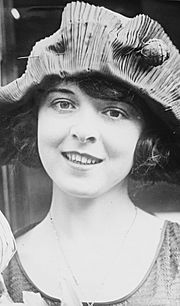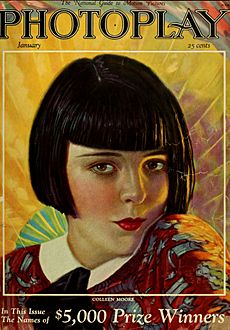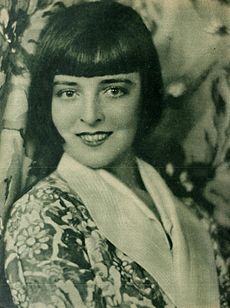Colleen Moore facts for kids
Quick facts for kids
Colleen Moore
|
|
|---|---|

Moore in 1920
|
|
| Born |
Kathleen Morrison
August 19, 1899 Port Huron, Michigan, U.S.
|
| Died | January 25, 1988 (aged 88) Paso Robles, California, U.S.
|
| Occupation | Actress |
| Years active | 1916–1934 |
| Spouse(s) |
John McCormick
(m. 1923; div. 1930)Albert P. Scott
(m. 1932; div. 1934)Homer P. Hargrave
(m. 1937; died 1964)Paul Magenot
(m. 1983) |
| Relatives | Walter Howey (uncle) |
| Signature | |
 |
|
Colleen Moore (born Kathleen Morrison; August 19, 1899 – January 25, 1988) was a famous American film actress. She started her career during the silent film era, when movies had no sound.
Colleen Moore became one of the most stylish and highest-paid stars of her time. She even helped make the bobbed haircut very popular!
Sadly, about half of her films are now lost, including her first movie with sound from 1929. Her very famous film, Flaming Youth (1923), is also mostly lost, with only a small part remaining.
Moore took a break from acting between 1929 and 1933, just as sound was being added to movies. When she returned, her four sound films in 1933 and 1934 were not very successful. After that, she stopped acting in movies for good.
After her film career, Colleen Moore kept her money safe and even grew it by making smart investments. She became a partner at a big investment company called Merrill Lynch. She later wrote a book to teach others how to invest in the stock market.
Moore also loved dollhouses her whole life. She helped design and create "The Colleen Moore Dollhouse," which has been a special exhibit at the Museum of Science and Industry in Chicago since the early 1950s. This amazing dollhouse is about 9 square feet and was valued at $7 million in 1985. About 1.5 million people visit it every year!
Contents
Early Life and Dreams
Colleen Moore was born Kathleen Morrison on August 19, 1899, in Port Huron, Michigan. She was the oldest child of Charles R. and Agnes Kelly Morrison. Her family lived in Port Huron for her early years, sometimes with her grandmother.
By 1905, her family moved to Hillsdale, Michigan, and later to Atlanta, Georgia, by 1908. They also lived briefly in Warren, Pennsylvania, before settling in Tampa, Florida, by 1911.
When she was 15, she took her first step toward Hollywood. Her uncle helped her get a screen test with director D. W. Griffith. She wanted to be like another famous actress, Lillian Gish, but instead, she often played heroines in Western movies with stars like Tom Mix.
Colleen had two big passions: dolls and movies. Both would become very important later in her life. She and her brother even made their own small theater from a piano box! Her aunts often bought her tiny furniture for her dollhouses, which she loved. Her family spent summers in Chicago, where she enjoyed baseball and visiting her Aunt Lib and her husband, Walter Howey. Walter Howey was an important newspaper editor and inspired a character in the famous play and film The Front Page.
Becoming a Star
Starting in Hollywood
Colleen Moore's journey to Hollywood began with help from her uncle, Walter Howey. He knew film producer D. W. Griffith, who owed him a favor. This helped Colleen get a chance to act.
She had to pass a special film test because she had heterochromia (one brown eye and one blue eye). They needed to make sure her eyes wouldn't look strange in close-up shots. She passed the test and moved to Hollywood with her mother and grandmother.
Colleen's first credited film was The Bad Boy in 1917. For the next few years, she played small roles, slowly gaining attention from the public. Her third film, Hands Up!, was a Western. She didn't know how to ride a horse, but her co-star Monte Blue quickly taught her the basics.
After her first film company went out of business, Colleen found work with Selig Polyscope Company. She starred in A Hoosier Romance and Little Orphant Annie. Both films were very popular and gave her a first taste of fame.
By 1919, Colleen was making a name for herself. She filmed The Wilderness Trail with Tom Mix and The Busher with John Gilbert. She also made The Man in the Moonlight and The Egg Crate Wallop.
Rising to Fame
Colleen then decided to try comedy and joined the Christie Film Company. She made films like Her Bridal Nightmare and A Roman Scandal. She also worked on other films like The Devil's Claim and His Nibs.
A director named Marshall Neilan really wanted Colleen to work for him. He succeeded and made Dinty with her in 1920. Neilan often loaned Colleen to other studios. She worked with King Vidor on The Sky Pilot and with John Barrymore on The Lotus Eater.
In 1922, Colleen Moore was named a WAMPAS Baby Star, which recognized her growing popularity. That year, she met John McCormick, a publicist who was very impressed by her. They soon got engaged.
By 1923, Colleen signed a contract with First National Pictures. Her first two films for them were The Huntress and Flaming Youth.
Colleen and John McCormick got married while Flaming Youth was being made. When Flaming Youth was released in 1923, it was a huge hit! Colleen became famous for playing a "flapper," a young woman who was fashionable and independent. However, another actress, Clara Bow, soon became the top flapper star. Colleen later said that Bow was her "chief rival."
Colleen continued to make successful films. She showed her acting range in movies like So Big, where she played a character who aged many years. She also did well in comedies like Irene.
She injured her neck while filming The Desert Flower, which stopped production for six weeks. After she recovered, she finished the film and went on a successful tour in Europe. When she returned, she signed a new, very good contract with First National because her films were so popular.
Her next films included We Moderns, Irene, and Ella Cinders. In 1927, Colleen left her studio after her husband, John McCormick, quit. It's believed she did this to help him get his job back, and it worked! McCormick became her only producer. This allowed Colleen's movies to become very big and fancy.
Lilac Time was a huge World War I drama that cost a million dollars but earned it all back quickly. This success helped Colleen keep her good contract terms and her husband as her producer, even after Warner Bros. took over First National.
Colleen Moore's Fairy Castle (Dollhouse)
In 1928, Colleen Moore, with help from her father and a set designer, created an amazing dollhouse. It was 9 square feet, and its tallest tower was 12 feet high! The inside of "The Colleen Moore Dollhouse" has tiny bear skin rugs, detailed furniture, and art.
This special dollhouse has been a popular exhibit at the Museum of Science and Industry in Chicago since 1949. The museum says 1.5 million people see it every year, and it's worth about $7 million. Colleen continued to work on it and add items to it until she passed away.
This was the eighth dollhouse Colleen owned. Her first one, she wrote, grew from a cabinet that held her collection of tiny furniture.
Sound Films and Later Life
When talking pictures became popular in 1929, Colleen Moore took a break from acting. After divorcing John McCormick in 1930, she married a stockbroker named Albert Parker Scott in 1932. They lived in a beautiful home in Bel Air and supported the U.S. Olympic team.
In 1934, Colleen Moore, now divorced from Albert Parker Scott, returned to Hollywood. She appeared in three more films, but none were very successful. After that, she retired from acting for good. Her last film was The Scarlet Letter in 1934.
She later married Homer Hargrave, who was a widower. She helped raise his children, Homer Hargrave Jr. and Judy Hargrave, and stayed close to them throughout her life. Colleen never had children of her own. She also remained good friends with other silent film stars like King Vidor and Mary Pickford.
In the 1960s, Colleen Moore started a television production company with King Vidor. She also wrote two books: How Women Can Make Money in the Stock Market (1969) and her autobiography, Silent Star: Colleen Moore Talks About Her Hollywood (1968). She was also a successful real estate broker in Chicago and a partner at the investment firm Merrill Lynch.
At the peak of her fame, Colleen Moore earned $12,500 per week, which was a huge amount of money back then! She was a very smart investor and stayed wealthy for the rest of her life. In her later years, she often went to film festivals and loved talking about her Hollywood career. She even appeared in the documentary series Hollywood (1980), sharing her memories of the silent film era.
Personal Life
Colleen Moore was married four times. Her first marriage was to John McCormick in 1923, and they divorced in 1930. In 1932, she married stockbroker Albert P. Scott, but they divorced in 1934.
Colleen's third marriage was to Homer Hargrave in 1936. He helped fund her famous dollhouse. She adopted his son, Homer Hargrave, Jr., and his daughter, Judy Hargrave. They were married until Homer's death in 1964. In 1982, she married Paul Magenot, and they were together until her death in 1988.
Death and Legacy
Colleen Moore passed away on January 25, 1988, at age 88 from cancer in Paso Robles, California.
For her amazing contributions to the movie industry, Colleen Moore has a star on the Hollywood Walk of Fame at 1551 Vine Street.
The famous writer F. Scott Fitzgerald once wrote about her: "I was the spark that lit up Flaming Youth, Colleen Moore was the torch." This shows how important she was to the "flapper" image of the 1920s.
Filmography
| Year | Title | Role | Preservation Status |
|---|---|---|---|
| 1916 | The Prince of Graustark | Maid (Uncredited) | Unknown/presumably lost |
| 1917 | The Bad Boy | Ruth | Unknown/presumably lost |
| An Old-Fashioned Young Man | Margaret | Lost | |
| Hands Up! | Marjorie Houston | Lost | |
| The Little American | Nurse (uncredited) | Exists | |
| The Savage | Lizette | Lost | |
| 1918 | A Hoosier Romance | Patience Thompson | Unknown/presumably lost |
| Little Orphant Annie | Annie | Exists | |
| 1919 | The Busher | Mazie Palmer | Exists |
| The Wilderness Trail | Jeanne Fitzpatrick | Lost | |
| The Man in the Moonlight | Rosine | Exists | |
| The Egg Crate Wallop | Kitty Haskell | Exists | |
| Common Property | Tatyoe (Tatyana) | Lost | |
| A Roman Scandal | Mary | Exists | |
| 1920 | The Cyclone | Sylvia Sturgis | Lost |
| Her Bridal Nightmare | Mary | Exists | |
| When Dawn Came | Mary Harrison | Exists | |
| The Devil's Claim | Indora | Exists | |
| So Long Letty | Grace Miller | Exists | |
| Dinty | Doreen O'Sullivan | Exists | |
| 1921 | The Sky Pilot | Gwen | Exists |
| His Nibs | The Girl | Exists | |
| The Lotus Eater | Mavis | Lost | |
| 1922 | Come on Over | Moyna Killiea | Unknown/presumably lost |
| The Wampas Baby Stars of 1922 | Self | Unknown/presumably lost | |
| The Wall Flower | Idalene Nobbin | Lost | |
| Affinities | Fanny Illington | Unknown/presumably lost | |
| Forsaking All Others | Penelope Mason | Unknown/presumably lost | |
| Broken Chains | Mercy Boone | Exists | |
| The Ninety and Nine | Ruth Blake | Incomplete | |
| 1923 | Look Your Best | Perla Quaranta | Unknown/presumably lost |
| The Nth Commandment | Sarah Juke | Incomplete | |
| Slippy McGee | Mary Virginia | Unknown/presumably lost | |
| Broken Hearts of Broadway | Mary Ellis | Exists | |
| The Huntress | Bela | Unknown/presumably lost | |
| April Showers | Maggie Muldoon | Unknown/presumably lost | |
| Flaming Youth | Patricia Fentriss | Incomplete (one reel exists) | |
| 1924 | Through the Dark | Mary McGinn | Incomplete |
| Painted People | Ellie Byrne | Lost | |
| The Perfect Flapper | Tommie Lou Pember | Exists | |
| Flirting with Love | Gilda Lamont | Unknown/presumably lost | |
| So Big | Selina Peake | Lost (trailer exists) | |
| 1925 | Sally | Sally | Lost |
| The Desert Flower | Maggie Fortune | Lost | |
| We Moderns | Mary Sundale | Lost | |
| Ben-Hur | Crowd extra in chariot race | Exists | |
| 1926 | Irene | Irene | Exists |
| Ella Cinders | Ella Cinders | Exists | |
| It Must Be Love | Fernie Schmidt | Lost | |
| Twinkletoes | Twink "Twinkletoes" Minasi | Exists | |
| 1927 | Orchids and Ermine | "Pink" Watson | Exists |
| Naughty but Nice | Bernice Sumners | Exists | |
| Her Wild Oat | Mary Brown | Exists | |
| 1928 | Happiness Ahead | Mary Randall | Lost (trailer exists) |
| Oh, Kay! | Lady Kay Rutfield | Exists | |
| Lilac Time | Jeannine Berthelot | Exists (Vitaphone music + sound effects) | |
| 1929 | Synthetic Sin | Betty | Exists (Vitaphone music + sound effects) |
| Why Be Good? | Pert Kelly | Exists (Vitaphone music + sound effects) | |
| Smiling Irish Eyes | Kathleen O'Connor | Lost (soundtrack exists) | |
| Footlights and Fools | Betty Murphy/Fifi D'Auray | Lost (soundtrack exists) | |
| 1933 | The Power and the Glory | Sally Garner | Exists |
| 1934 | Social Register | Patsy Shaw | Exists |
| Success at Any Price | Sarah Griswold | Exists | |
| The Scarlet Letter | Hester Prynne | Exists |
See also
 In Spanish: Colleen Moore para niños
In Spanish: Colleen Moore para niños





